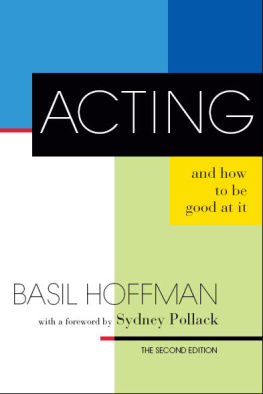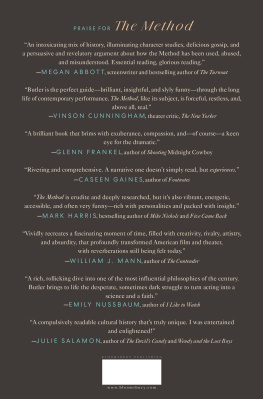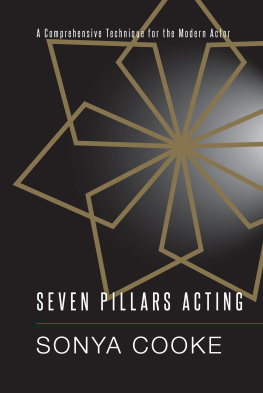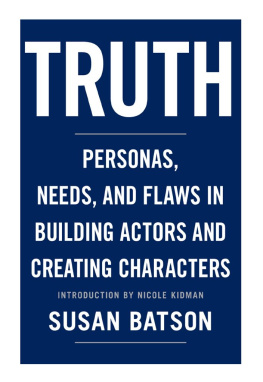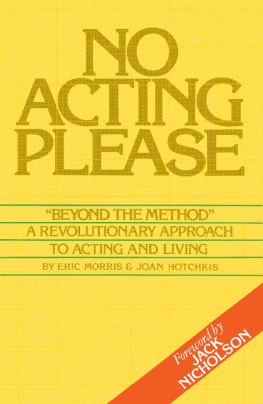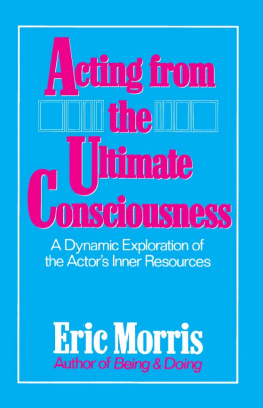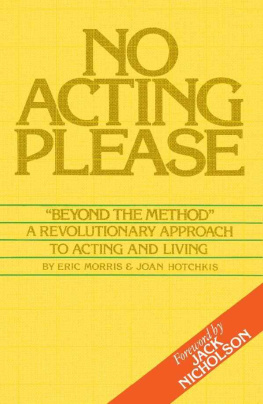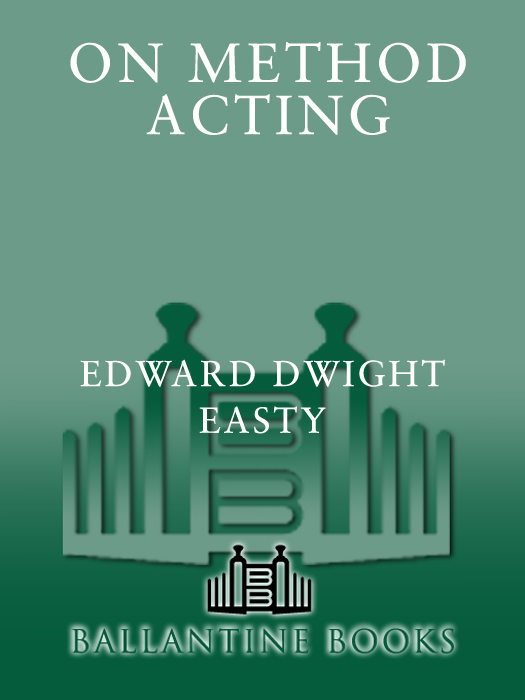ON METHOD ACTING
An actors instrument is his whole self. It is his body, his mind and being, complete with thoughts, emotions, sensitivity, imagination, honesty, and awareness. Try to imagine the actors instrument in much the same way you picture the musician and his violin, the artist and his canvas, paints, and brushes. Think of them as one and inseparable. Just as the musician practices daily on his instrument, always perfecting its response to his will through training, and the artist mixes his paints, brushing them on with the precision and beauty accrued only by drill, so must the actor be concerned with the training and development of his instrument and its responses to his commands.
An Ivy Book
Published by The Random House Publishing Group
Copyright 1981 by The House of Collectibles, Inc.
All rights reserved.
Published in the United States by Ivy Books, an imprint of The Random House Publishing Group, a division of Random House, Inc., New York, and simultaneously in Canada by Random House of Canada Limited, Toronto.
No part of this book may be reproduced or utilized in any form or by any means, electronic or mechanical, including photocopying, recording, or by any information storage and retrieval system, without permission in writing from the publisher.
Ivy Books and colophon are trademarks of Random House, Inc.
www.ballantinebooks.com
Library of Congress Catalog Card Number: 78-61740
eISBN: 978-0-307-82377-9
v3.1
Foreword
I n the mid-thirties, as a freshman at Northwestern University at a time when the American theatre was largely a commercial flight away from reality, I saw a play out of the Goodman Theatre in Chicago that changed a lot of lives, including my own.
It began when I walked into the theatre and felt a tenseness, an animal excitement in the air that I associated more with a sports arena before a championship fight than with the rustle of playbills and small talk that preceded the few commercial plays I had seen.
There was no curtain. The actors, or were they actors, were seated in a semi-circle on a bare stage. Others had been liberally planted in the audience. A tough looking character who looked like one of Al Capones torpedoes from the nearby south side, lolled against the proscenium, arrogantly picking his teeth and sizing up the audience.
Then with no dimming of lights, it began to happen. A man, slob fat, was standing downstage center, his hands raised for quiet. Then it began to happen. He was blasted from the audience with defiance, with catcalls, whistles, boos. And I can hear that fog horn of a voice still bellowing over the defiance into the four corners of what was now not a theatre but a Union Hall, and we were members, we were there: Youre so wrong, I aint laughing!
What followed in that small packed space was not so much a play as an experience, a galvanizing, unforgettable experience that had us all on our feet at the end wholly involved in one of the life and death social realities of the thirties, shouting: STRIKE! STRIKE! STRIKE!
The play was WAITING FOR LEFTY by Clifford Odets, a member of the Group Theatre which was a community of working artists under the leadership of Harold Clurman, Cheryl Crawford and Lee Strasberg. These three exceptional people were committed to a serious theatre rooted in an awareness of the individual and social realities of the time, and to a systematic training of actors to use themselves creatively as instruments in working for truth and reality on the stage. Alive and growing experimentally for some time, the Group Theatre was now ready in the year 1935 to take a dramatic giant step forward.
With WAITING FOR LEFTY, AWAKE AND SING, TILL THE DAY I DIE, and PARADISE LOST, all by Odets and all produced in a single year, the Group captured the direction of the American theatre, stood four square against its commercial flight away from reality, and opened up a new world of creative possibilities for writers, directors and actors.
And although the Group was dissolved in 1941, its experiment and its achievement remains a dominant one in the American theatre. In one area, certainly, it has permanently altered the course of its history. This area is defined in this book by Mr. Easty.
Out of the Group emerged one of theatres finest artists, undoubtedly the greatest American teacher of acting in our time, Mr. Lee Strasberg. His work and influence in the modification, development and practical application of Stanislavskys System of training actors to use themselves consciously as instruments to attain truth and reality on stage is now general and decisive. In fact, it might be hard to find an American actor of stature who has not been influenced directly or indirectly by Mr. Strasbergs years in the theatre. For twenty years, Mr. Strasberg has conducted classes in acting. In that time, by the hundreds each year, students and working actors have enrolled to learn and to work; to absorb what they can of Method acting from its greatest teacher. One such student was Edward Easty, the writer of this book. He studied with Strasberg for over a decade. Out of that experience, he has written this book on Method acting. Written for the layman as well as for the young actor, it has two great virtues in a difficult and often murky fieldit covers the ground with simplicity and with clarity. And it does cover the ground.
It is more than a reference book on the Method, although it can be used most profitably as such; it is much more than a book by a student who has learned his lessons well. It is Mr. Eastys instrument, as it were, working well and creatively when he wrote this book. He had assimilated his years with Mr. Strasberg, years packed with creative experience, and out of it, with perception, organization, and a special talent for the task, he has written a book eminently readable as prose. It moves along in an exciting and provocative way. It is beautifully detailed. His ability to follow an actors thought process while engaged in a specific task, the questions that must be answered if he is to attain reality in his work, should be of tremendous value to the actor who is just entering the mazes of the Method. In short, the book has a sound and style of its own.
I have not exhausted the virtues of Mr. Eastys ON METHOD ACTING. His relating the truth and reality of an actors art to the truth and reality with which he lives his daily life, the books keen and dramatic sense of anecdote, and the sections on Marilyn Monroe and James Dean are all beautifully conceived.
I will say that it ought to be required reading for young actors or the layman who wishes to understand the mysteries of Method acting in clear and simple terms. And that is as far as I go. The book that follows speaks most eloquently for itself.
ROBERT HERRIDGE
Contents
Introduction
U pon reaching the end of my writing of this book, I realized that there is much more that could possibly have been said on the subject. I want to say more but at the same time know that one book, or even volumes, cannot say it all; for art grows faster than all the writers of the world can record it. The salient facets of Konstantin Sergeyevich Stanislavskys System as it has evolved to us today are the only parts I have discussed in this book. They are the very basis of the modern Method teachers way of teaching. Those readers familiar with Stanislavskys writings will ask what has happened to other aspects of his teachings. I can only answer that the facets set forth in this book are the ones in general use today by the leading proponents of his system. The rest of his teachings are either incorporated into what I have included or have been dropped because of their impracticality for the Western theatre.


